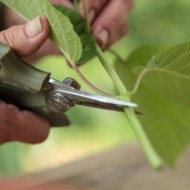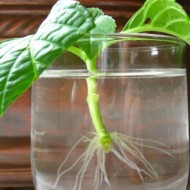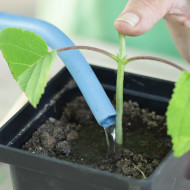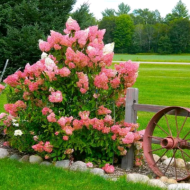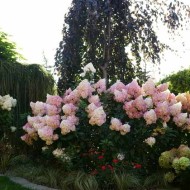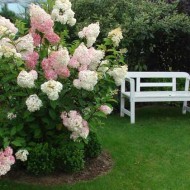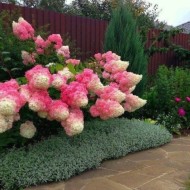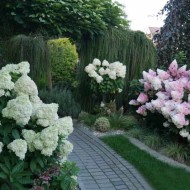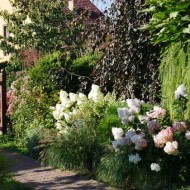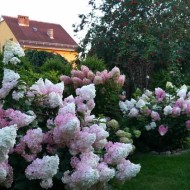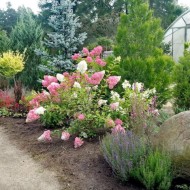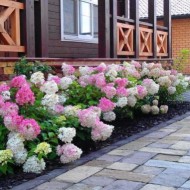How to use Vanilla Freise hydrangea in your garden design: florist guidelines
Content
History of origin and description of the variety
Hydrangea Vanille Fraise was bred by a group of French breeders working in the Pepinieres Renault nursery. The scientific group was headed by the founder of the kennel Eric Reno. Work on the breeding of decorative culture began in 1989. And only in 2003, the final version of the Vanilla Freise variety was presented. In some botanical reference books it can be listed as Vanilla Fries.
The plant got its name - Vanilla Freise - for the complex color of the inflorescences. Translated from French, vanille means vanilla, and fraise means strawberry.

Ornamental characteristics of the bush
Vanilla Fraz is a panicle hydrangea. The plant can reach a height of 2 m. The crown of the shrub is spreading, wide. The color of the bark is dark burgundy with a red tint. Under the weight of flowers, young shoots can sag down, giving the shrub a spherical shape.
Oblong leaves are formed along the entire length of the shoots. The leaf blades are characterized by a dark green color. There is a slight pubescence on the outside of the leaf, which is often called a velvet cover.
Flowering features
A distinctive feature of the variety is wide-pyramidal massive inflorescences of strawberry-vanilla color. The average length of one inflorescence is 30–35 cm. At the initial stage of flowering, the flowers are white. Gradually, the white shade is replaced by pink. Towards the end of the growing season, the color of the flower becomes strawberry red.
The average flowering time is 5 months. The first inflorescences appear in June. Under favorable weather conditions, the plant will delight with a riot of delicate colors until mid-October.

Video "Planting hydrangea Vanilla Fraze"
This video shows how a sapling of an ornamental culture is planted in open ground.
General rules for planting hydrangeas
Paniculata hydrangea is planted in the ground in late spring - in the second decade of May.
Requirements for light, soil and moisture
Hydrangeas grown in the south are planted in partial shade. For gardeners of the northern regions and central Russia, it is better to look after the site on the south side of the garden. At the same time, decorative culture does not like wind and draft.
Prefers fertile and loose soil of neutral acidity. But the calcareous or sandy environment is considered detrimental to the plant. The best option is a combination of leafy earth, sand, peat and humus.

Seedling planting algorithm
The planting hole is prepared a few days before planting the seedling.If you plan to plant several shrubs, a distance of 1–2 m is maintained between the holes. The dimensions of the planting pit are 30x30x30 cm. With high soil moisture, the bottom of the planting pit is laid out with expanded clay, gravel or broken brick. Drainage prevents the formation of stagnant moisture in the soil.
At the end of planting, the hydrangea needs to be watered and mulched. Mulch maintains an optimal balance of nutrients in the soil.
Other breeding methods
The seed propagation method is used in practice only by experienced gardeners. The laborious and time-consuming process is not suitable for novice summer residents.
The easiest way to propagate an ornamental shrub is green cuttings. Cuttings are cut in the spring. Each cutting should have several healthy buds. The plant is placed in Kornevin solution for rapid root formation. When the roots appear, the cutting is transplanted into a container with nutrient soil.
- Propagation of hydrangea by green cuttings
The intricacies of caring for hydrangea Vanilla Fraze
Panicle hydrangea is one of the undemanding flowering ornamental crops to care for.
Watering mode
A moisture-loving culture requires frequent and abundant watering - at least 2 times every 7 days. Up to 10 liters of settled water is poured under one bush. If the summer is wet and rainy, the interval between watering can be increased up to 1 time in 7 days.
After each watering, surface loosening and mulching of the soil is carried out. These procedures inhibit the growth of weeds and inhibit the leaching of nutrients from the soil.
Fertilization
A richly flowering hydrangea needs a lot of nutrients. The first top dressing is recommended to be performed after 2-3 weeks after planting the seedling in a permanent place of growth. For fertilization, plants use organics diluted with water.
In the future, you can feed Vanilla Fraz according to the following scheme:
- In the spring, during the formation of buds, organic fertilizers diluted with water (15: 1) are introduced into the soil.
- At the stage of formation of the first buds, re-feeding with organic diluted water (15: 1) is carried out.
- In the summer, during the period of active flowering, ready-made solutions are used to fertilize hydrangeas and azaleas. Alternatively, you can use a homemade nutritional formula containing potassium salt, superphosphate, and ammonium nitrate. Each substance is taken in 30 g, the finished mixture is diluted with water.
- In the fall, during preparation for the upcoming cold weather, 30 g of potassium sulfate and superphosphate are added under each bush.
Pruning and shaping the bush
Panicle hydrangea needs annual pruning. In autumn, gardeners remove faded brushes and shoots injured by bad weather.
Forming pruning is carried out in the spring before the start of sap flow. Dried, insect-damaged and unhealthy-looking branches are removed completely. The rest of the shoots are shortened to 6-8 buds.

Wintering features
Vanilla Freise is one of the most winter-hardy varieties. In the description of the variety, it is noted that the plant can withstand frosts down to -35 ° C. Due to its high winter hardiness, it can be grown throughout the territory of Russia, including the northern regions.
Shrubs grown in the north are insulated for the winter. Dry opal foliage, burlap, agrofibre or pine spruce are used as insulation.
Protection against diseases and pests
The Vanilla Fraze variety suffers from invasions of snails, slugs, spider mites and aphids. Insecticidal preparations "Akarin" and "Tanrek" help to fight harmful insects.
As for diseases, panicle hydrangea weakly resists powdery mildew and various types of rot.To prevent the development of the fungus, preventive spraying of the crown of the shrub with the fungicides Fundazol, Topaz or Fitosporin will help.
Hydrangea Vanilla Fraze in landscape design
A beautifully flowering ornamental shrub is actively used in landscape design for decorating park areas, city squares and even the local area. The plant looks best in solitary plantings. Can be used as a hedge.
Spiraea, barberry, mock orange and rhododendron will become worthy neighbors of the panicle hydrangea. Neighborhood with juniper, thuja and pines can be called classics. But bulbous crops, which require an annual transplant, are considered not the most successful neighbors.
- Variants of using hydrangea Vanilla Fraz in landscape design
Gardeners reviews
“Vanilla Fraze is my favorite variety of panicle hydrangea. It has been growing in the garden for many years. With minimal maintenance, it pleases with generous and long flowering. "
“Last year I bought a panicle hydrangea sapling of the Vanilla Freise variety. The plant quickly adapted to our climate. Difficulties and problems with cultivation have not yet been observed. "
Vanilla Freis is the perfect blend of simplicity and sophistication. Simplicity should be understood as the absence of difficulties with care, by sophistication - the amazing beauty of a flowering shrub.

